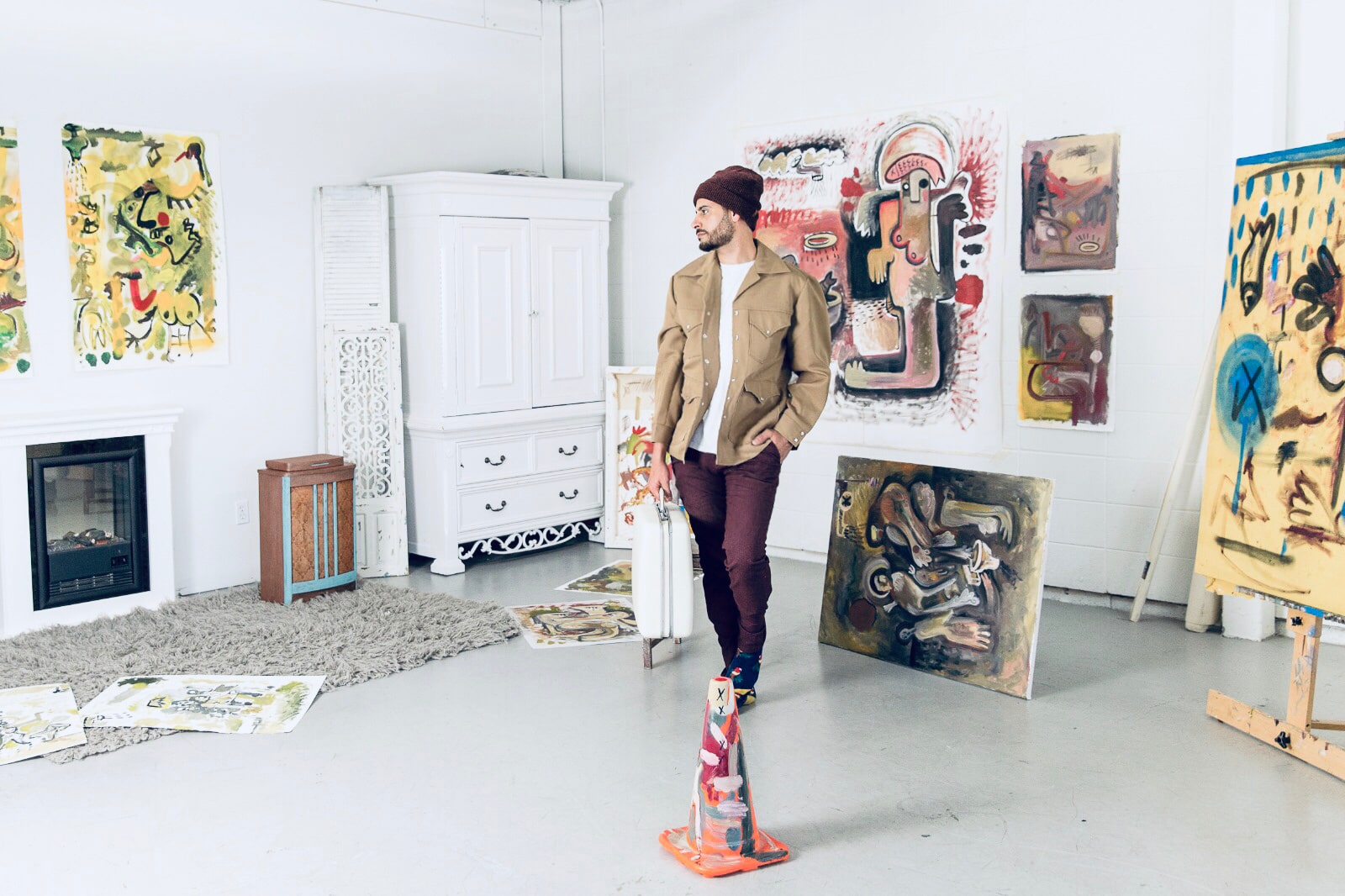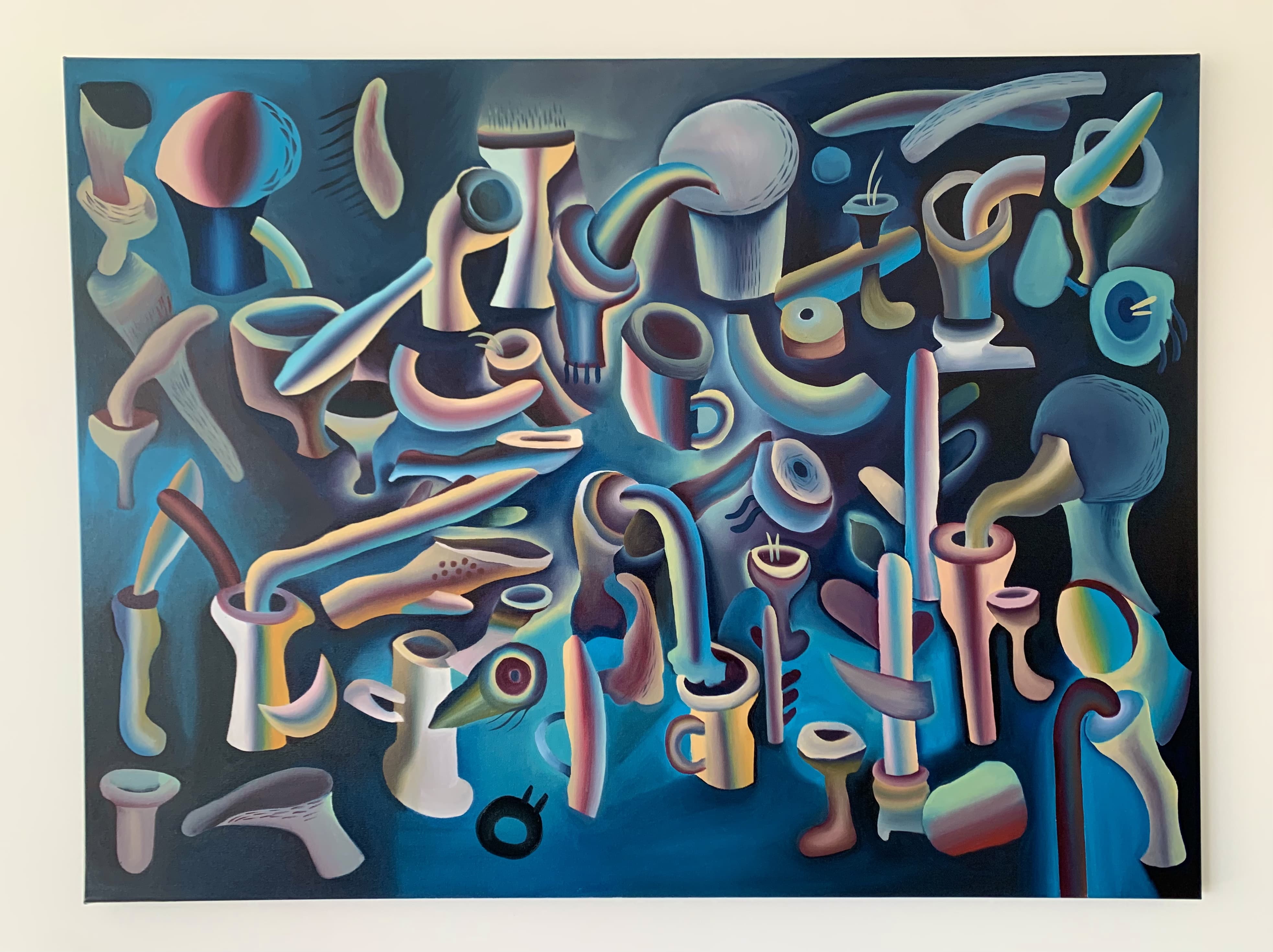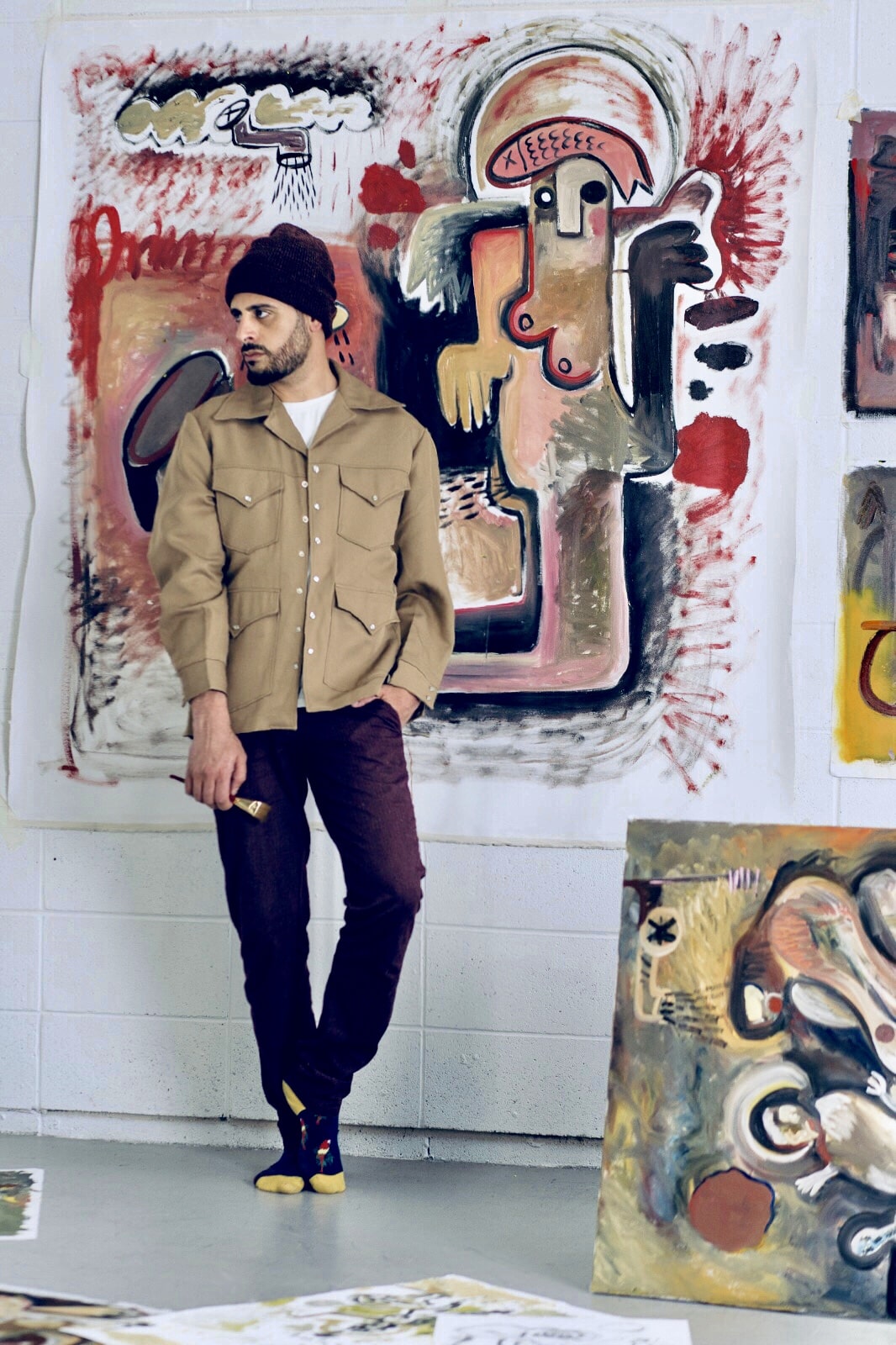Lifestyle
Art Under Occupation: Palestinian-Canadian artist Hanny Khoury talks art, identity, and belonging

Palestinian-Canadian artist Hanny Khoury has spent years thoughtfully exploring his identity, trying to establish his understanding of what it means to be Palestinian.Art has always been his lifeline, an outlet where he channels frustrations and emotions, seeking a means of representing his past in a way that empathizes with an international audience. From Palestine to Canada, his journey has been difficult and encouraging, a true redemption arc that’s far from over.
Khoury grew up in a small village in historical Palestine-one of six children-under the Israeli occupation. As far back as he can remember, his identity, and the identities of his family and neighbors, were conflated with the information being spread by the occupation. “You are a Palestinian, a minority living under occupation. The environment is weird, nothing is clear.You can’t identify yourself and you don’t grow up with a clear identity that’s solid,” says Khoury.“From school to the media, the occupation is basically programming your brain, to make you forget your identity.”

Art was the one thing that could ground Khoury to something tangible. It was a means of coping with the instability of his daily life and allowed him to express his confusion. As he describes, it was a means of creating an entirely new world: “It’s like I was creating my own environment, my own life, the way I wanted it to be. With time, art became a healing process for me. It became the one thing through which I rebuild the relationship with everything around me and make peace with it. Heal it. That’s how art spoke to me. Art became like food for me, or water.”Even when his parents struggled to afford necessities, his mother would use soil and flowers to make natural pigments he could paint with. Walls, doors, broken pieces of wood-anything could serve as a canvas in Khoury’s eyes.
Eventually, after years of tension, both internally and with his environment, he made his way to Canada. This fresh start opened his mind, and he finally found the space and time to focus on his practice. It was during this period that he began to consider the parameters of being a Palestinian artist in a contemporary context. As a child, Khoury’s sources of artistic inspiration were limited to what was acceptable under the occupation. Names from Western art history, like Salvador Dali and Pablo Picasso, were tolerable, but examples of Palestinian art were scarce. “Back then, I didn’t have anything that made me a Palestinian artist. I got this sense of belonging later in life, through my own research. I developedan awareness about our existence as Palestinians and then my art started to belong to the history and the story of Palestine. Before that, I didn’t have the opportunity to learn that information,” says Khoury.

Through his studies and careful research, Khoury began to form his own idea about the critical difference between being a Palestinian artist and producing Palestine art. “I think the Palestinian story of identity loss, it had its own time,” he explains.“Silman Mansour, Nabil Anani, Ismail Shammout-those artists had to do it because they had to construct their identity and the identity of the Palestinian people. For us, as the young generation in or from Palestine, we must do something different. We have to work with an international language, while still belonging to the Palestinian identity.” Khoury’s search for identity is also a search for expression, finding a way to leverage Palestinian form to resonate on an international, even universal, level.
Currently represented by Mark Hachem Gallery, Khoury’s work is set to make an impression on audiences around the world. He has already made great strides with his ability to translate his own experiences into a visual, emotionallanguage that anyone can connect with. “What I have suffered in my life, the experiences, the journey I had in Palestine-this is what developed my international language of art. This is where it came from. The figures, the colors, the balance. Everything that makes up my work is Palestinian, but the figures themselves aren’t necessarily Palestinian,” he explains. “Art is translating the time period that we live in, visually.The modern world of art is not translating specific moments, it’s translating specific emotions. We talk about our conflicts, our difficulties, our pain, the system. That’s what we talk about as artists. So, when we look at art, it should deliver emotion. It doesn’t necessarily have to do with belonging to the physical world. It can be connected to the emotional world, or faith.” Confident and passionate, Khoury is forging ahead with a new vision of what Palestinian art could be, offering the next generation of young artists what he was denied growing up: an inspirational figure.
Lifestyle
How Magic Moment Resort Became the Pioneer of a New Era: The First-Ever Dazzler Select by Wyndham

In Central Florida’s packed landscape of family hotels and theme park lodgings, a unique kind of property has emerged. Magic Moment Resort & Kids Club in Orlando is earning attention from traveling families for a simple reason. It delivers joy, warmth, and convenience at a smart value that keeps Disney dreams accessible rather than overwhelming.
By joining Wyndham, Magic Moment Resort unlocks the strength of a global powerhouse, gaining worldwide visibility, advanced technology, and access to Wyndham Rewards, the largest hotel loyalty program on the planet. This strategic move expands its reach, builds guest trust, and amplifies its impact, all while preserving the unique identity that sets it apart.
Just a short drive from the gates of Walt Disney World, the resort sits along the palm-framed stretch of West Irlo Bronson Memorial Highway. The location has long been known for its tourism bustle, yet Magic Moment has carved out a softer identity. It feels playful and colorful, but also intentional. It is designed by a family for other families, and that perspective shapes every experience on the property.
A Philosophy Rooted in Family Connection
Magic Moment Resort was built with a belief often forgotten in today’s tourism industry. Family vacations should feel uplifting instead of stressful, and affordability should not come at the expense of comfort or creativity.
Check-in feels more personal than transactional. Parents arrive with strollers, snacks, and tired children. The staff seems to understand this rhythm instinctively. The energy is warm, the pace is easy, and the tone is set long before anyone even enters the room.
Unlike competing hotels that charge a steep premium for proximity to the parks, Magic Moment focuses on smart value without compromise. Its pricing strategy is refreshingly straightforward. Families can stay five minutes from Disney without draining their travel budgets. For many guests, that difference helps shift resources from hotel costs to experiences. It means more character breakfasts, more souvenirs, and more freedom to enjoy the parks without financial tension following every decision.
Spaces Designed for Children and Considerate of Parents
Magic Moment is filled with color, but nothing feels overstimulating. Instead, the resort offers a sense of wonder scaled to a child’s imagination.
The themed family rooms are a highlight. Children step into rooms that feel lighthearted and whimsical, yet parents appreciate that they are also functional and comfortable. It is the atmosphere of a themed suite without the theme park price.
Its Kids Club and Teens Club reflect that same thoughtful balance. These spaces invite exploration and creativity for children and provide a nurturing level of supervision. Parents can enjoy an hour by the heated pool, relax in a shaded cabana, or simply take a quiet moment while knowing their children are safe and engaged.
The resort’s grounds encourage slow mornings and gentle afternoons.There’s a 30,000 sqf outdoor playground as well as peaceful corners for parents. Importantly, families are not asked to pay additional fees to enjoy them. Magic Moment’s amenities feel generous rather than transactional.
Unforgettable Days at the Parks
For families navigating a Disney vacation, convenience is often the true luxury. Magic Moment delivers this with a complimentary delicious hot breakfast that encourages everyone to sit and enjoy the start of the day rather than rush through it.
Transportation to the parks is included, which removes one of the most common stress points for visiting families. There is no parking lot maze and no long lines at the toll booths. Guests simply board the shuttle and begin their day with ease.
When the sun sets and everyone returns from a day of rides and parades, the resort becomes a place to unwind. Children head straight for the pool. Parents sip Starbucks coffee. The atmosphere is relaxed and bright, and the resort feels like an extension of the Disney experience rather than a pause from it.
A Value That Resonates with Families
What truly elevates Magic Moment is the balance it achieves between smart value and experience. The resort has cultivated a loyal following because guests feel they receive more than they pay for. More thoughtful design. More space for connection. More comfort without excess.
Affordability here does not signal minimalism. Instead, it allows families to breathe. It creates space for shared moments that are often overlooked in the rush of theme-park vacations. Children play freely. Parents unwind without guilt. Families spend more time together and less time navigating logistics.
A Resort Built with Heart
Magic Moment Resort & Kids Club stands out in a region overflowing with hospitality options. Its charm is not rooted in extravagance. It is grounded in sincerity. It reflects the belief that family travel should feel joyful, accessible, and full of color.
For families planning a Disney visit, it represents more than a place to sleep. It is a retreat where memories can form in the quiet moments as much as in the thrilling ones.
At Magic Moment, the greatest luxury is not an amenity. It is the feeling of being exactly where you are meant to be, together.
-

 Tech5 years ago
Tech5 years agoEffuel Reviews (2021) – Effuel ECO OBD2 Saves Fuel, and Reduce Gas Cost? Effuel Customer Reviews
-

 Tech6 years ago
Tech6 years agoBosch Power Tools India Launches ‘Cordless Matlab Bosch’ Campaign to Demonstrate the Power of Cordless
-

 Lifestyle6 years ago
Lifestyle6 years agoCatholic Cases App brings Church’s Moral Teachings to Androids and iPhones
-

 Lifestyle5 years ago
Lifestyle5 years agoEast Side Hype x Billionaire Boys Club. Hottest New Streetwear Releases in Utah.
-

 Tech7 years ago
Tech7 years agoCloud Buyers & Investors to Profit in the Future
-

 Lifestyle5 years ago
Lifestyle5 years agoThe Midas of Cosmetic Dermatology: Dr. Simon Ourian
-

 Health7 years ago
Health7 years agoCBDistillery Review: Is it a scam?
-

 Entertainment6 years ago
Entertainment6 years agoAvengers Endgame now Available on 123Movies for Download & Streaming for Free
